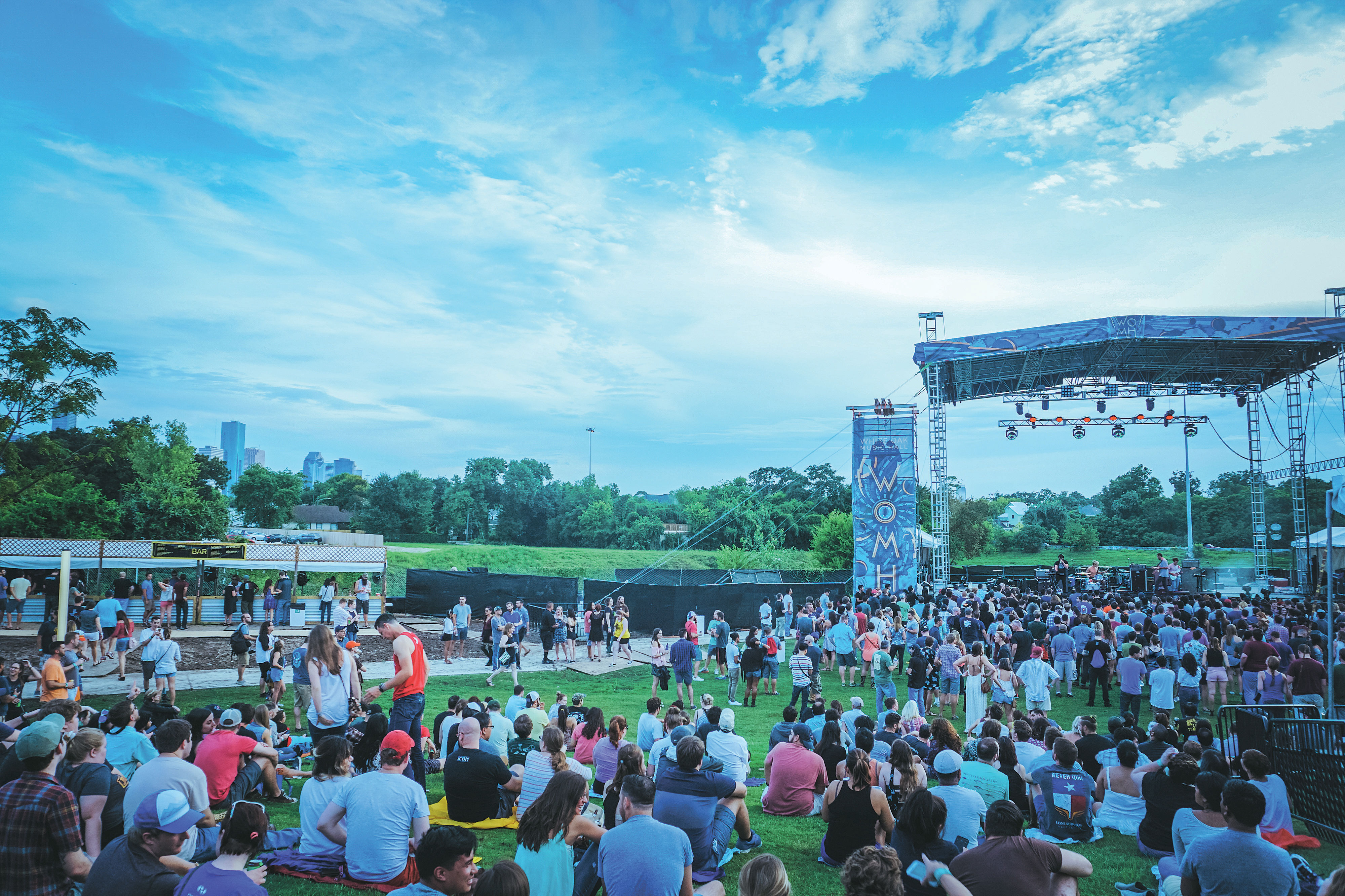
How White Oak Music Hall Hit a Series of Flat Notes with Its Northside Neighbors
The parcel of land that White Oak Music Hall now occupies was, until recently, an overgrown mess. On this, at least, everyone agrees.
Near Northsiders use adjectives like “junky,” “dilapidated” and “seedy” to describe the plot on North Main, east of I-45. Trash and drug paraphernalia were strewn in and around White Oak Bayou, which floats just to the south. Stray cats and dogs roamed freely.
So there was cautious optimism when Will Garwood, a financier, and Will Thomas, a criminal defense attorney and musician, purchased the property a few years back and announced their intentions: to construct and operate “Houston’s best live music venue.” Thomas had wanted to run a concert hall for a long time; frustrated by his day job, he’d occasionally cruise through EaDo scouting potential locations, never finding exactly what he was looking for. All the components presented themselves on the plot Garwood finally had identified, a half-mile from the Quitman light rail stop, beside a retired machine shop.
“It’s always been a commercial spot,” Thomas says, squinting through the sun one February afternoon, the downtown skyline sprouting in the distance. “It’s between a big pedestrian corridor, a freeway, and a bayou. There are businesses all the way up to the freeway. Then you have this great view of downtown. And, it was just a big, empty piece of land.”
One of their first tasks was clearing out Raven Tower, the property’s boxy crow’s nest (and Near Northside landmark), where an eccentric former shop owner, R.W. Walker, once lived, complete with orange carpet, Murphy bed and rooster weathervane. In 2014, they convinced Johnny So and Jagi Katial, of the concert-promotion company Pegstar, to book and manage their events. Meetings with neighborhood groups and city officials followed.
By 2016, a full-fledged entertainment campus had been erected, unlike anything in Houston to date: two state-of-the-art indoor stages, an open-air pavilion, a bar (the eponymous Raven Tower), and the White Oak Music Hall Lawn, the grassy centerpiece with space for 3,500 outdoor concert-goers. The project’s price tag, footed by private investors, reportedly shot north of $10 million.
Inside, no detail was ignored. The curved banks of speakers hugging the main stage are custom-built. Dozens of wood panels flank the walls, spaced at distances precisely measured to add richness to the acoustics. And the luxurious green room upstairs, designed by local favorite Gin Braverman, offers an unimpeded view of the lawn, where the French electronic band M83 kicked off White Oak’s high-profile outdoor schedule in April of last year. The rush that Thomas felt during those early shows, he says now, was “indescribable.” On Reddit, one attendee likened the atmosphere to “a music festival without the chaos.”
But chaos is exactly what Theresa Cavin claims she experiences every time a band plugs in on White Oak’s lawn. A mother of three children including a newborn, Cavin has long lived in Glen Park, the leafy, Heights-y pocket neighborhood adjacent to the venue; Raven Tower is visible from her porch. Saved on her smart phone are videos of the outdoor concerts that have repeatedly disrupted her “sleepy neighborhood” over the past year. She pulls up a clip of The Lumineers, who sold out White Oak on a Saturday night a year ago. The folksy guitars and the crowd’s roar cut through quite clearly.
“Great band,” Cavin says, “but …”
Linda Longoria Vargas has her own stored videos, including one of the Pet Shop Boys, who came through Houston in November. Members of Vargas’s family have lived on the same Glen Park block for over a century. She’s raising two daughters here, one 8 and the other 5. Her youngest has a sensory-processing disorder, which makes excess noise especially difficult to handle. “She’s crying, covering her ears and chest,” Vargas says. “When the cars start pulling up, it’s like, ‘Oh no, not again.’”
Both women are among the nine plaintiffs who, in January, won a temporary injunction on White Oak’s outdoor shows from a Harris County judge. (Cavin’s 9-year-old autistic son, Austin, is also named in the suit.) Judge Kristen B. Hawkins, who made the initial ruling, stated that she feared residents might endure “imminent and irreparable harm” should the shows proceed unchecked. As part of that ruling, White Oak was ordered to purchase and install sound monitors along the property’s perimeter, with measurements sent to the court weekly.
A trial to determine whether or not the injunction will be applied permanently is set this month, for May 15. It’s a booking White Oak wishes they could cancel.

Neighbors Theresa Cavin (left) and Linda Longoria Vargas (right) have filed a lawsuit against White Oak.
Image: Michael Paulsen
Seen from one angle, this conflict was entirely predictable. Houston’s population is booming. The inner loop is denser than it’s ever been. At the same time, our lenient land-use regulations allow law-abiding owners to (mostly) build what they want, (mostly) where they want it. Thus, a world-class concert venue butts up against a tract of single-family homes. Externalities ensue.
“What we’re seeing is a clash of new development coming into our old neighborhoods,” says city councilwoman Karla Cisneros, whose Northside district includes White Oak. “And I think there’s a good chance there will be more clashes to come. We have a lot of people that are trying to find a life for themselves in the same space.”
The Bayou City isn’t completely unregulated when it comes to land use rules, as the national stereotype suggests, but its lack of formal zoning—which Houstonians have voted to preserve—does mean that residents wary of a certain development in their backyards often need resources and political know-how to block its construction.
The partners had always intended to build what Thomas calls “a big, beautiful, awesome, iconic outdoor stage,” of the kind that Houston has noticeably lacked. Hermann Park’s Miller Outdoor Theatre mostly hosts classical programming—symphonies, ballets, operas and musicals—while the Cynthia Woods Mitchell Pavilion in The Woodlands, a 40-minute trek from downtown, has long filled the gap for big outdoor rock shows and the like. That is what animated Thomas and Garwood’s earliest discussions; the indoor venue was actually Pegstar’s idea.
But the circumstances by which White Oak secured its outdoor stage permit have left the partners vulnerable to criticism. Building a permanent stage, they say, required more time and money than they had available last winter. So they started booking outdoor acts before they’d raised the necessary capital.
In April 2016, they were granted a temporary outdoor stage permit, which lasts six months, and tossed up a makeshift stage on the lawn. When that initial permit expired, last October, the city issued the venue a permanent stage permit, along with a second temporary permit, which lasted another six months and was conditional upon White Oak making investments in their permanent infrastructure. The move was unorthodox, though not expressly prohibited by city statute.
The plaintiffs have seized on this series of events, claiming White Oak initially sold the neighborhood on a drastically different—and quieter—lawn concept, only to roll out their blueprints for what attorney Cris Feldman calls a “mosh pit stage” once it was too late for anyone to fight back. The Near Northside Neighborhood Council signed a Memorandum of Understanding in support of the project in January 2015, only to amend that memorandum 20 months later because “the scope of the WOMH development has changed significantly since the agreement was signed.”
The White Oak team wholeheartedly denies any obfuscation. “Every time we had to re-erect the temporary stage, and we hated it!” So counters. “But it’s been portrayed as some kind of backdoor, surreptitious attempt to skirt the law.”
Today, bitterness has set in. The litigious neighbors feel spurned, bullied, overlooked. They say White Oak hasn’t taken their concerns seriously, hasn’t taken reasonable measures to abate the evident noise, for which they’ve received periodic citations. And anyway, they lament, the sound ordinance is far from perfect; bass vibrations are difficult to measure, and local police forces tasked with enforcing violations are spread thin.
Feldman hopes that, come May 15, the court will make the temporary injunction permanent, and will grant his clients $1 million in damages. He’s also requested a separate hearing from the city attorney’s office to revoke the venue’s outdoor sound permit. “We don’t want any more outdoor music, plain and simple,” he says. And the nine plaintiffs would love to see City Council simultaneously broaden Houston’s sound ordinance to, in Feldman’s words, “protect children and working families from abuse.”
On the other side, you’ve got the White Oak partners, who seem genuinely worn down by the controversy. As they point out, these contested outdoor shows—two or three per month, three to four hours in length—make up only a percentage of their overall slate. Moreover, they did loads of due diligence on this project before it launched, they say, and they’ve tried to meet their critics halfway. Several community members who sat in on early planning meetings back them up on that count.
The partners have added more parking and hired additional traffic cops, mollifying early logistical complaints. They’ve also fundraised for the local high school and invested in a bayou-beautification project. “If we were greedy developers,” Thomas says, “we wouldn’t be in the music business, period. We’d build a strip center, lease it out, and move on to the next thing.”
There are plenty of Near Northside residents who are supportive of White Oak’s efforts, it should be noted. They appreciate the group’s ambition, not to mention the caliber of artists that the lawn can attract and accommodate. Cisneros says that since she took office a year ago, she’s called numerous meetings “to facilitate communication” between the various parties.
“There’s good people all around,” she says. “Everybody cares very deeply about the Near Northside, and what is the best thing to do. They are looking at things from very different angles.”
Civility, of course, is in everyone’s best interest. After a recent court hearing, one of the plaintiffs gave Thomas a lift to his car. Another stopped by the venue recently—it is a great place to hang out, and nobody’s arguing otherwise.

Caught in a bitter dispute: White Oak managing partners Will Garwood, Johnny So, Jagi Katial and Will Thomas
Image: Michael Paulsen
When we spoke to them this winter, ahead of the trial, the White Oak team was busy preparing for two previously scheduled outdoor concerts that Judge Hawkins was still allowing them to host, on April 30 (The Pixies) and May 20 (The Randy Rogers Band). And their indoor schedule—their financial bread and butter—continued to be as jammed as ever.
One Tuesday night in March, we headed to White Oak to take in an indoor show. Right at 8 p.m., the house lights dimmed and the smoke machine kicked on. Flower Graves, a five-piece band playing an appealing combination of psychedelic and garage rock, took the stage.
The lead singer, in red-denim jacket and sunglasses, slipped a baby-blue guitar over his fuzzy pompadour. A few notes were noticeably flat, which he apologized for while slugging on a Lone Star tallboy. “Forgive my voice—this Texas weather is really f*****g with me,” he said into the mic. The crowd was vibing anyhow. In no way is White Oak Music Hall a dive, we mused, but it doesn’t feel bland or overly corporatized, either. It’s a modern room with palpable Houston soul.
Outside, the sidewalks were empty. The temporary stage, the source of this year-long battle, rested on its hill behind some chain-link fencing, silent. We remembered a story So had told us, about a night the venue hosted an evening show, when he decided to stroll through Glen Park. This was after the lawsuit had already been filed. It was dark.
“These two guys are sitting on their porch drinking beer,” he remembered, “and they see me walking around, and they say, ‘Hey, are you with White Oak?’”
So met them at their fence line. He could make out one of the plaintiff’s houses nearby: “I was like, ‘Who are these guys rolling up on me?’ I thought they were going to beat me up.”
“To be honest with you,” one of the neighbors told him, “they are just hating on you. We really like you here.”
So smiled, dropped his guard.
“I just wish you had better bands,” the guy said. “Y’all need to have more metal shows.”













































